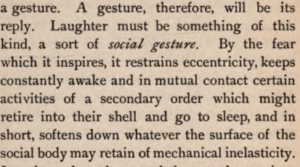
Bergman, in his essay on laughter, makes a particularly interesting claim that laughter could be seen as “a sort of social gesture” in supposed response to the ‘societal inelasticity’ of the comic character. This is an extension of his overall wider argument concerning laughter as a ‘corrective’ of human behaviour – he even assumes that its nature is “intended to humiliate, it must make a painful impression on the person against whom it is directed”(p.197). Bergson’s general idea of the comic is then perhaps limited to a figure which audiences will laugh at, instead of laughing with the figure – which could perhaps be seen as a limitation of Bergman’s analysis, if I’ve read this right. I could be just stupid, though. In any case, the fundamental principle remains – the concept of social/mechanical inelasticity which Bergson assumes as the progenitor of comedic situations still stands.
This concept of laughter as a function to “convert rigidity into plasticity” made me think of this particular scene of Juzo Itami’s Tampopo (1989), and generally in the rest of Itami’s other works at large. Itami concerned his films often with cultural criticisms aimed at the contemporary culture of post-war Japan, and this particular scene from Tampopo satirises Japanese rigidity, pride and work culture. The scene concerns a business meeting between executives and one underclassman at a French restaurant. At first, Bergson’s analysis would lead us to view the underclassman as the comic figure, due to his inelasticity to the strict business culture as shown through his initial clumsiness, lack of superficial respect towards his superiors and general aloofness. Yet throughout the scene, this situation is reversed, and it is the executives who become the comic figures – as they cannot read French, their collective pride lead them to all default to the same order, whilst the underclassman, who is unnaturally aware of all things French, embarrasses them by composing an original order free of cultural ignorance. The potential laughter produced from this scene would perceivably be in attempt to correct or at least call attention to this rigidity, which we can assume Itami found comical enough to ridicule.
I think you’ve highlighted a really interesting argument made by Bergman, especially since, in the quote you have included, he emphasises the “fear” that laughter inspires. This also stood out to me from the reading as this is not an emotion I generally associate with laughter. I think this angle of laughter being seen as a tool for societal correction, whilst quite pessimistic, is definitely one of the key ways laughter is used in social situations.
I really like your idea about Bergson’s limitations. While I was very much interested in Bergson’s ideas and concepts regarding laughter as a human condition, I think it is also important to note that Bergson himself approaches the subject with a degree of rigid analysis that can betray his objective perception of comedy. His assertion that comedy must have that sort of vindictive dynamic, as you noted, is certainly one, and toward the end of the first chapter, when he claims storytellers and playwrights cannot rely on jokes alone, a claim which is entirely a product of its being published in 1911, before long-form pure slapstick content, such as The Three Stooges, was popular.